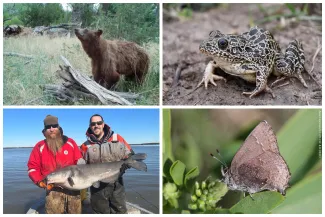The Wildlife Department is in the business of conserving Oklahoma’s fish and wildlife. And as with any business, conservation comes with its share of administrative tasks. Before any drift fence is built to catch crawfish frogs, or any hair snare is raised to collect black bear DNA, the Wildlife Department’s federal aid team must first pore through mountains of documents to secure federally distributed conservation funding.
“Our federal aid staff are a critical part of applying and implementing conservation in Oklahoma,” said Kurt Kuklinski, a research supervisor for the Wildlife Department. “They help our project leaders take a conservation idea and shape it into a project with well-thought-out objectives so that it can become a conservation success story.”

The Wildlife Department's federal aid team administers a wide variety of federal grants and ensures conservation funding is spent responsibly.
Applying Conservation Funding with a Focus
Behind each of the Wildlife Department’s conservation grants is a four-person federal aid team working in conjunction with field staff to compile project statements, budget tables, risk assessments, and compliance documents to make sure the funding is used responsibly.
“A lot of times, we’re so tied up with paperwork and Excel spreadsheets that we don’t realize we’re contributing to the individual projects,” said Treager Stout, a grants assistant with the Wildlife Department. “But when we take time to reflect, we realize that we’re affecting conservation on a daily basis.”
On any given day, Stout and his colleagues Jessica Brown, grants specialist Amy Newcomb, and federal aid coordinator Andrea Crews, may work with dozens of grants to ensure purchases align with the grant objectives and follow a multitude of other state and federal grant requirements. In fiscal year 2023 alone, the team administered 117 conservation grants, ranging from ongoing habitat work on Wildlife Management Areas; to studies of wild turkey, spotted skunks, blue catfish, and Texas horned lizards; to the installation of public shooting ranges and fishing docks.
Their meticulous oversight has helped the Wildlife Department earn the public’s trust as a good biological and fiscal steward.
Crews said, “It’s awesome to know we’re doing our part for conservation and bringing our skill set to the table.”
Two Years of Planning and Paperwork
To illustrate how an idea is shaped into a project, Kuklinski explained how the Wildlife Department developed and eventually funded the recent study of Oklahoma’s Panhandle black bears.
“The process leading up to day one – the start of the funded grant – was somewhere in the neighborhood of two years.”
In the summer of 2020, Kuklinski kicked off the Wildlife Restoration Research Committee, where biologists discussed federal grant opportunities to study the state’s wild birds and mammals, including the potential to gather data about the black bear population in Cimarron County.
Data gaps and research questions were identified, and the need to study western Oklahoma bears was included in a larger “request for proposals” sent to research teams across the region. The proposals, including an offer from Oklahoma State University to deploy trail cameras and hair snares for black bears in the Panhandle, were reviewed, and funding recommendations were made to the agency’s administration.
With funding approved, Kuklinski’s next step was to forward finalized grant details to the Wildlife Department’s federal aid team.
“This is a critical time in the process,” Kuklinski said. “Our federal aid team gathers and reviews the documents to set up the grant with the U.S. Fish and Wildlife Service, and we have multiple conversations with the principal investigators to make sure the project hits the mark.”
Once expectations for the grant were set and questions were addressed, the Panhandle bear project was approved by the USFWS to begin Jan. 1, 2022. Staff at Oklahoma State University then began purchasing supplies and assigned a graduate student. The first trail cameras were deployed in May 2022 – two years after the idea of collecting data about western black bears was first discussed.
After two years of planning and paperwork, two field seasons of data collection, and two annual reports, the western bear study is seemingly all but over.
“Even though a grant may be ‘over,’ the reality is that it’s not over for us,” said federal aid coordinator Andrea Crews.
The grant’s final report is scheduled to be submitted in June 2024, and the federal aid team will still need to review and submit the document to the U.S. Fish and Wildlife Service and the Oklahoma Digital Prairie, and confirm Oklahoma State University has completed its obligations before closing the Wildlife Department’s books.
Crews said, “This bear project will still get a lot of oversight through state and federal audits long after it is closed to make sure conservation funding has been used responsibly.”
Though the administrative work is often overshadowed by secretive frogs, big catfish, or black bears, it’s a crucial part of applying and implementing conservation.
“We’re doing all we can to safeguard the conservation funds – to make sure those dollars are spent correctly and yield conservation effect,” Kuklinski said. “Without our federal aid staff, we wouldn’t be able to do the conservation work that the Wildlife Department is known for.”
The Wildlife Department works closely with the U.S. Fish and Wildlife Service’s Southwest Region to administer a variety of federal grant projects. Along with traditional grants for game species, the agency utilizes grants to improve habitat on private lands, offer additional land access, and learn about species that aren’t hunted or fished.